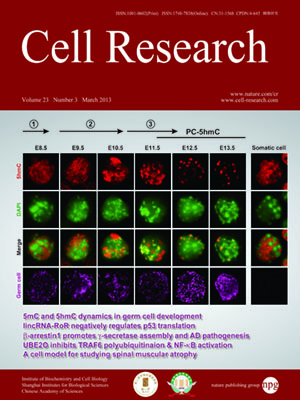
Volume 23, No 3, Mar 2013
ISSN: 1001-0602
EISSN: 1748-7838 2018
impact factor 17.848*
(Clarivate Analytics, 2019)
Volume 23 Issue 3, March 2013: 329-339
ORIGINAL ARTICLES
Dynamics of 5-methylcytosine and 5-hydroxymethylcytosine during germ cell reprogramming
Shinpei Yamaguchi1,2,3, Kwonho Hong1,2,3, Rui Liu6, Azusa Inoue1,2,3, Li Shen1,2,3, Kun Zhang6 and Yi Zhang1,2,3,4,5
1Howard Hughes Medical Institute, WAB-149G, 200 Longwood Av., Boston, MA 02115, USA
2Program in Cellular and Molecular Medicine, WAB-149G, 200 Longwood Av., Boston, MA 02115, USA
3Division of Hematology/Oncology, Department of Pediatrics, Boston Children's Hospital, WAB-149G, 200 Longwood Av., Boston, MA 02115, USA
4Department of Genetics, Harvard Medical School, WAB-149G, 200 Longwood Av., Boston, MA 02115, USA
5Harvard Stem Cell Institute, WAB-149G, 200 Longwood Av., Boston, MA 02115, USA
6Departments of Bioengineering, University of California at San Diego, La Jolla, CA 92093-0412, USA
Correspondence: Yi Zhang(yzhang@genetics.med.harvard.edu)
Previous studies have revealed that mouse primordial germ cells (PGCs) undergo genome-wide DNA methylation reprogramming to reset the epigenome for totipotency. However, the precise 5-methylcytosine (5mC) dynamics and its relationship with the generation of 5-hydroxymethylcytosine (5hmC) are not clear. Here we analyzed the dynamics of 5mC and 5hmC during PGC reprograming and germ cell development. Unexpectedly, we found a specific period (E8.5-9.5) during which both 5mC and 5hmC levels are low. Subsequently, 5hmC levels increase reaching its peak at E11.5 and gradually decrease until E13.5 likely by replication-dependent dilution. Interestingly, 5hmC is enriched in chromocenters during this period. While this germ cell-specific 5hmC subnuclear localization pattern is maintained in female germ cells even in mature oocytes, such pattern is gradually lost in male germ cells as mitotic proliferation resumes during the neonatal stage. Pericentric 5hmC plays an important role in silencing major satellite repeat, especially in female PGCs. Global transcriptome analysis by RNA-seq revealed that the great majority of differentially expressed genes from E9.5 to 13.5 are upregulated in both male and female PGCs. Although only female PGCs enter meiosis during the prenatal stage, meiosis-related and a subset of imprinted genes are significantly upregulated in both male and female PGCs at E13.5. Thus, our study not only reveals the dynamics of 5mC and 5hmC during PGC reprogramming and germ cell development, but also their potential role in epigenetic reprogramming and transcriptional regulation of meiotic and imprinted genes.
Cell Research (2013) 23:329–339; doi:10.1038/cr.2013.22; published online 12 February 2013
FULL TEXT | PDF
Browse 2254


